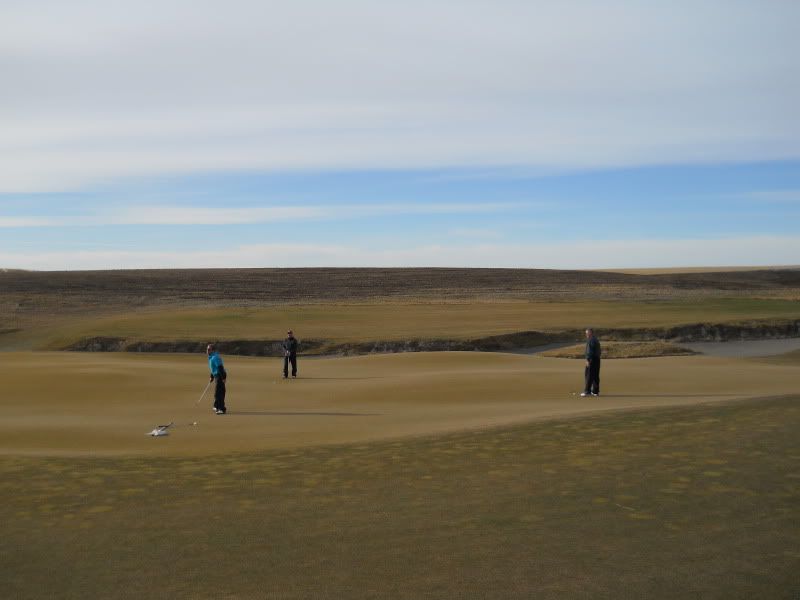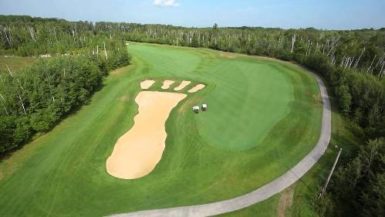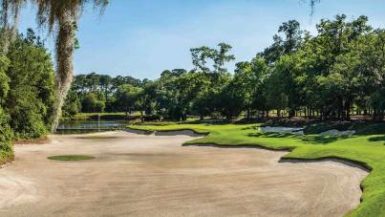
Day 3 – Gold Mountain, (Olympic Course)
5:15 a.m., Seattle
No matter how many times I do it, waking up in darkness isn’t for me. My body clock is used to the California hours that all entertainment lawyers keep, even in New York. (If a Cali lawyer calls you at 4:59 his time and you’re not there, as Ian Faith said, “they start screaming like a bunch of Poncey hairdressers.”)
Once again Garmin tried it’s hardest to send me to Bandon Dunes instead of Gold Mountain, giving me bizarre instructions to leave the highway and take a route I knew to be longer and more circuitous. I’m lucky I got there at all. There are some serious woods up here, really tall timber. At one point, the fir trees were so thick it seemed the only person to ask directions from would be the Blair Witch. A winding road finally led past a sign for the facility and a few more turns through the woods brought me (finally) to Gold Mountain.
8:45 a.m., Bremerton
Gold Mountain has hosted a U.S.G.A. Junior Amateur (won by Peter Uihlein) and a U.S. Amateur Public Links, but it is best known for it’s excellent value. Walk-ups paid $24 to play today, $30 if they wanted to play all day long. The course’s highest rate in high season for non-locals is $60, but you can frequently get in a round for far less. Golf Digest once called it the second best value in America, and Golf Magazine praised its egalitarian price structure also. They are both right. A country-club-for-a-day atmosphere and high quality golf course at that price? As my dad would say, “That’s a bargain all day long!” Like Bowling for Soup rock ‘n’ roll – it’s champagne quality at beer prices.
The Olympic Course is the flagship at the facility and has an interesting story behind its creation. Back in the mid-’90s a consulting firm did a study and determined that it would not be feasible to build a second course at Gold Mountain. That firm’s numbers all indicated that a second course just couldn’t sustain itself economically. Enter Director of Golf Scott Alexander and friends.
“I kept careful track of how many groups got turned away and showed my figures to the powers that be,” explained Alexander. “I found that we turned away 65,000 people in a single year. That’s not good business.” Faced with indisputable evidence that Washingtonians would be thrilled to have an additional course, they tapped hometown favorite John Harbottle to design it.
It’s a local-boy-done-good feel-good story. Harbottle has spent his life around golf. His mother is Pat Lesser Harbottle, one of the Pacific Northwest’s most recognizable and famous golf champions. She won the 1955 U.S. Women’s Amateur. His father was also a golf pro.

It was only Harbottle’s third design on his own, but he learned at the elbow of Pete Dye and roomed with Tom Doak during that time, so you know he was encouraged to be creative.
“Pete taught me all about routing a golf course and about balancing lengths of shots and directions of shots, and requiring fade off the tee and draw into the green on one hole, and then draw off the tee, fade into the green on the next,” Harbottle stated energetically. “And he taught me to keep the ground game in play. Keep fairways wide, but require there to be a right side and wrong side of the fairway.”
And that’s exactly what you find at the Olympic Course at Gold Mountain. Extremely wide fairways, sometimes as much as 80 yards across, with excellent horizontal movement, (and therefore, multiple ways to play the hole), yet tightly guarded greens with good internal movement. Off the tee, bunkers are turned perpendicular to the line of play. The rolling terrain makes it easy to design bold holes that, nevertheless, follow the natural lay of the land. Oftentimes, Harbottle opt for deep grass bunkers as hazards, which he calls “dungeons,” as an interesting spin.
As an aside, both Harbottle and Alexander are well over six feet tall. I’m 5’7″ and change, so playing with them is a little like when Frodo was travelling with Gandalf and Aragorn, but still as eager as gun dogs who heard their master take the firing piece of the shelf above the fireplace, we line up for golf on a cold, blustery January day, hot cocoa as well as golf clubs in our trolleys.
It was great fun, despite the cold. The short par-4 second has a bunker cut diagonally in the liner of play you can try to avoid or carry.
“It’s one of my favorites,” beams Harbottle, “a really interesting drive-and-a-pitch hole.”
My favorite on the front was the uphill par-4 4th hole which begins a tee shot meant to carry or avoid a perpendicularly turned bunker that juts into the fairway, followed by an approach over a deep center-line green to a shallow plateau green with interesting contours.
Yet another excellent perpendicularly-placed bunker appears at the par-5 11th, another of Harbottle’s favorites.
“You have to make a choice. You can safely lay up about 100 yards short of bunker, but that leaves you a full shot into a shallow plateau green that sits at diagonal to you,” Harbottle observes. Challenging the hazard and carrying the green presents you with a much better angle, straight into the deep part of the green.”
The finishing stretch provides the most interesting options on the golf course. At the par-3 16th, you get some of the elements of the architectural bloodline of Macdonald, Raynor, and Banks.

“This par-3 over water has elements of both Eden hole and the Lion’s Mouth, two of my favorite templates of Macdonald. The Eden part is that the green is wide to line of play, but you need to carry it over hazards and get close to pin to get birdie. Like the original at St. Andrews, over the green is dead,” Harbottle begins. The front bunker is the Lion’s Mouth bunker, with the gull wings of the green around it,” he concludes.
The par-4 17th has a fairway bisected diagonally by a stream. Long hitters can play down the left – the more dangerous side, but the shorter route to the green. Finally, the 300-yard closing hole features a green surrounded by water and sand and can serve up anything from eagle to triple bogey. It does what all great tempting holes do – gives you just enough rope to hang yourself.
As an aside, I usually prefer a tough finisher. A truly great golf course needs a sterling closing hole: a summary of all that came before. While you get everything but the kitchen sink at 18 at the Olympic Course, it can be a pushover if you want to play safe. It’s much stronger as a match play hole.
That being said, many great courses end on a hole which plays a “half stroke easier,” such as Cypress Point (a short par-4) and Bandon Dunes (a short par-5). 18 at Gold Mountain proved to be great fun for the Junior as it had all the kids thinking, and that’s the hallmark of a great golf hole.
Gold Mountain won’t beat up the bogey golfer, but will play tough for the expert. The wide fairways give you more room to play the game, tack your way around the course, and recover from the occasional bad shot. It’s not overly long – the 6,600 member tees are negotiable for the average golfer, so long as he plays intelligently.
If there is a one drawback, the course may get a little repetitive off the tee – you see the same “dip and a rise” to hit over on many tee boxes. We’re not averse to blind shots here, but there was a feel of sameness off the tee on some of the par-4s and par-5s.
That being said, the course is great fun and an even better deal. It’s definitely a source of great pride for Washington golfers and with good reason.
Day 4 – Wine Valley

5:00 a.m. Ugh. This 5 a.m. wake-up call is getting difficult and I desperately need coffee.
It’s a five hour drive across the state – from Seattle to Walla Walla – to get to one of the country’s hottest new golf destinations, and the road takes you across several diverse ecosystems. The road first climbs into the mountains and past two of Washington’s ski resorts. The snow, ice, and cold make for a tough drive, even on the four-lane highway, especially when semis come roaring by as ludicrous speeds.
Then the road takes you across high desert, past rugged, rolling hilltops and verdant gorges. At one point, you turn out of a hillside pass and city in a valley lies sleepily beneath you, tucked cozily in the vale. Finally, you arrive in wine country.
The drive out there was certainly worth the five hours. The golf course is a marvel. We’ll have a much more in-depth review next month and an interview with architect Dan Hixson to go along with it, but long-story-short, run don’t walk to Wine Valley. The greens are that good.
Some have called the course “a public Ballyneal.” While that may be a little strong, there are similarities. Both courses are in the middle of nowhere. Both courses have wild, hurly-burly greens with fierce contours. Both have a bold, natural look complete with blowout bunkers. Both are built over enormous areas, (Wine Valley is spread over 300 acres), yet both are minimalist in design, hardly any earth was moved during construction. Both courses play fast and firm. And both courses have an ardent cult following; each is the stuff of holy whispers by and among the golf cognoscenti.

Five and seven are the best holes on the front. At the long par-4 5th, a trench bunker runs along the left side off the tee, then cuts diagonally across the fairway. The seventh offers a marvelous punchbowl green with a mound shaped into the interior, a brilliantly original concept. I haven’t seen a green that good since Oakmont or Ballyhack.
On the back, you get a great cross-hazard at the par-4 12th, and a wondrous skyline green at the short, but uphill par-5 15th.
I also agree with local player Ken Cole from Waitsburg, Washington – the par-5s are the most memorable holes.
“My favorite holes are the par-5s,” he asserts. “Every one of them gives you a chance to go at it and get on in two, yet the bunkers are deep and penal. Those holes offer great risk-reward options, you can catch up in match play matches. Plus, the greens are fantastic.”
Wine Valley regular Mike White of greater Walla Walla also had some poignant observations.
“At this whole course you have options around the greens. You can bump and run, putt, or pitch. You have plenty of risk-reward options and you’re going to have birdie chances, maybe even eagle, but you can also get nailed on any hole,” explained White.
Then his eyes flash mischievously and he puckishly adds, “And you know the other great thing about this course? There’s no freakin’ trees! Old guys like me? We hate slogging around and punching out of the trees all day.”
That’s two other things Wine Valley has in common with Ballyneal: both allow the ground game and there’s no freakin’ trees.
As another aside, don’t you just love White’s enthusiasm? And his colorful assessment? Brilliantly laconic! “No freakin’ trees!” – It’s a catchphrase!
There’s no question that Wine Valley the second best course in the state of Washington – and to be spoken of in the same breath as Chambers Bay is rarified air indeed. There’s something for everyone at Wine Valley: Great views of the Blue Mountains, a rugged golf course, brilliantly conceived greens, multiple options on recovery shots, the grounds game, minimalism, “no freakin’ trees,” it’s the total package.
The drive back in the dark is long, with the climb through the mountains the worst. Semis fly by at ridiculous speedsduring a freak squall. Here, it’s snowing while at Wine Valley, miraculously, it was 50 degrees during the first week of January. My group played in windshirts. I played all three days even though weather reports called for occasional highs of 25. One week later, Seattle is in the vice like grip of winter, enduring its worst snowfall in five years – six inches and counting.
Meanwhile I had the best middle seat of my life on the flight back: the flight was supposed to be full, but the only person who missed the plane was the guy who had the window seat next to me. And if that’s not enough, the aisle seat was taken by a smokin’ hottie, a doctor with raven tresses, dusky eyes, and roller-coaster curves. I lost a little sleep, but ended up with her in my arms. Isn’t it great being single in New York?
Of course she did break one of the “Eight Simple Rules for Dating Jay Flemma.” Rule 8 clearly states “Don’t kiss me first and then tell me, you’ve had bronchitis for a week.” But whatever, I’ll give her a mulligan, she missed the memo when it came out.
6:40 a.m. Forest Hills
It’s warm in New York this morning, though it’s still dark. I hate winter. The sun rises too late, sets to early, and usually stays hidden behind grey, sullen, oppressive clouds. But this morning I’m basking in the afterglow.
Our great game gave me a timeless gift this week: the warm open-hearted camaraderie of Robert Trent Jones, Mike Davis, and Brian Simpson, the stunning beauty and originality of Chambers Bay, the easy-going friendship of John Harbottle and Scott Alexander, the wild beauty of Wine Valley, the gracious warmth of the Shelley family, and a shapely adorable at Trail’s End, the cherry on the sundae – BOO-YA!. Golf, God, and Country – add girl and sushi as needed. That’s what golf is all about – the people. In a few hours, it’s back to the law office, but for now, as my head hits the pillow for a well-earned rest, life is good.




